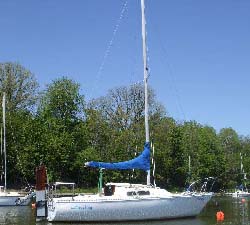CS 22
 A couple I knew were in the market for a 22 to 24 footer. They had been avid dinghy sailors, but with two children, six and three years of age, they wanted to switch to sailing a ballasted boat. “We can afford $7,000 to $8,000, and a trailerable boat would help keep annual costs down,” they advised me. I recommended the CS 22 without reservation for both monetary value and sailing enjoyment. I had crewed on a CS 22 in club races during the early ’80s, and knew the design as a comfortable and stable boat with surprisingly good performance. The sails are relatively small, and even spinnaker handling is no big chore. Reef early, keep her sailing flat, and the boat remains dry and comfortable in rough weather. Designed by John Butler of the U.K., this was the first boat for many Canadian sailors during the rapid growth of the sport in the 1970s. More than 500 were built by Canadian Sailcraft (now CS Yachts of Brampton, Ont.) between 1971 and 1976, before production was halted as the builder concentrated on larger models.
A couple I knew were in the market for a 22 to 24 footer. They had been avid dinghy sailors, but with two children, six and three years of age, they wanted to switch to sailing a ballasted boat. “We can afford $7,000 to $8,000, and a trailerable boat would help keep annual costs down,” they advised me. I recommended the CS 22 without reservation for both monetary value and sailing enjoyment. I had crewed on a CS 22 in club races during the early ’80s, and knew the design as a comfortable and stable boat with surprisingly good performance. The sails are relatively small, and even spinnaker handling is no big chore. Reef early, keep her sailing flat, and the boat remains dry and comfortable in rough weather. Designed by John Butler of the U.K., this was the first boat for many Canadian sailors during the rapid growth of the sport in the 1970s. More than 500 were built by Canadian Sailcraft (now CS Yachts of Brampton, Ont.) between 1971 and 1976, before production was halted as the builder concentrated on larger models.
The boats trailerability is made possible by its centreboard and an outboard rudder that lifts vertically, daggerboard style, in a cast aluminum bracket. In lighter winds when sailing off the wind, the board can be raised to reduce drag, a feature that will please former dinghy sailors. To meet the maximum trailerable width of its day, the beam was kept to eight feet. Today the maximum limit is six inches wider, which means modern trailerables can offer slightly more interior space.
The interior arrangement places a dinette to starboard, a quarterberth and mini-galley to port, and a V-berth (with proper ceramic head under the central cushion) forward of a partial bulkhead. The mini-galley consists of a small counter with sink and pumped freshwater. Many 22’s are equipped with a gimbaled one-burner “stove”; a few can be found with a two-burner installation. There’s no icebox. Five feet, four inches of headroom increases to six feet, four inches with an optional poptop and wraparound canvas curtain, although the standard model, with a sliding, lifting arrangement, allows standing headroom in the aft portion of the main saloon. The dinette folds into a small double berth, making the 22 a suitable cruising craft for two adults and two children. All of the interior space is very workable, given the restricted confines of a vessel this size.
Sail numbers of 194 or lower are accommodated under the class association racing rules despite slight differences in the rudder bracket and centreboard mechanism. Other than those divergences, the boats were built alike.
There have been minimal problems with the CS 22 over the years, with only a few raising some osmosis blisters near the waterline. The first boat, number 101, is still sailing. Some rudders have been broken in heavy seas when fully extended, but a composite rudder is available through the owner’s association. The centreboard pennant can break after years of wear, and should be checked seasonally.
Now that many of the boats are approaching the 20-year mark, gelcoat is getting chalky on the top-sides. A paint job with a linear urethane coating costs $100 to $125 per foot.
Overall, the CS 22 has proven to be a tough and durable boat with a good reputation. There is an active owner’s association, with highly competitive racing fleets in the Greater Toronto Area. Association members are scattered from Lake of the Woods to Prince Edward Island.
My friends eventually took my advice and bought a CS 22 in their price range (another one, complete with the trailer sold with the boat when new, would have cost closer to $10,000). She needed about $200 in maintenance, but is otherwise in good condition after 17 seasons.
I renewed my acquaintance with this pocket cruiser when I sailed with them early this past summer. The wind was a blustery 20 knots, with occasional rain showers, but the three of us were comfortable in the large cockpit as we reached at 5.5 knots under double-reefed main and working jib. She was easy to control and tacked positively, though we had to watch where we put our feet -she sucked water up the cockpit drains as the stern squatted whenever we exceeded her theoretical hull speed.
Nearly two decades after entering production, the CS 22 still admirably fulfills her role as a “starter” keelboat.
Members of the CS Owner’s Association receive a quarterly newsletter for their annual fees. The fee is $25 for those in the Niagara-on-the-Lake to Oshawa area of Ontario who can participate in regattas; for those further afield, $12.
Specifications
LOA 21 ft. 7”
Ballast 1,100 lbs.
LWL 17 ft. 6”
Sail Area 212 sq. ft.
Beam 8 ft.
Draft 2 ft./5 ft.
To see if this boat is available, go to http://www.boatcan.com to check listings!






















